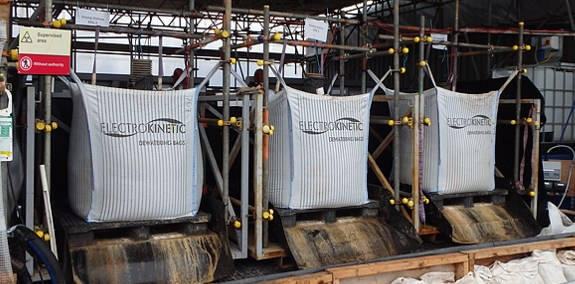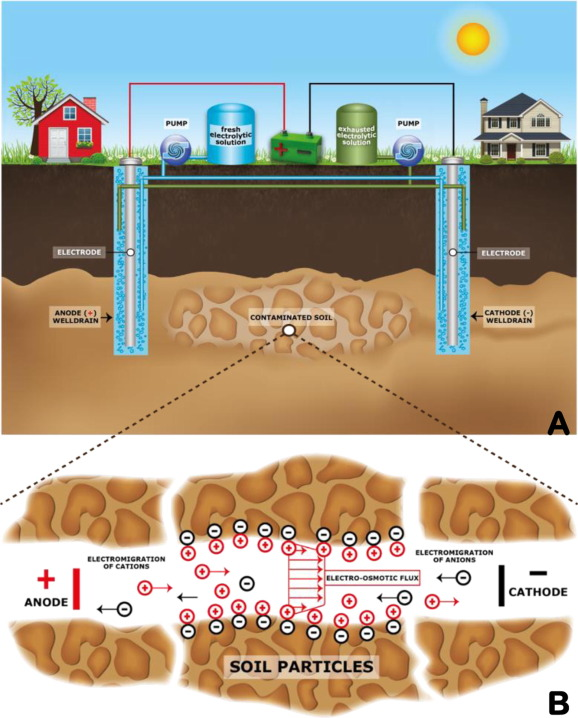Part 5 Plants as Water Protectors blog information series.
Article 5- Phytromediation Rafts with Electrokinetics
Article 4- Plants as Water Protectors
Article 3- Citizen Science Phytoremediation Research StLouis
Article 2- St Louis IKEA Phyto Buffer Zone pt2
Article 1- IKEAs lesser known environmental project
Examples of Companies involved in the Remediation of Soil, Water, Sludge, Contamination ponds.

When a DC electric field is applied to soil, cations begin to move toward the cathode and anions move toward the anode. Since soil typically has a negative surface charge there are more cations than anions in the pore water (conservation of charge). These extra cations, lined up along the pore walls and moving toward the cathode, drag the pore water along causing a net pore water flow to the cathode that is uniform and predictable. In low permeable soils (clays and silts), this process is much more efficient and thorough than conventional hydraulic based processes. The directional movement through the soil allows for the effective use of in-situ capture and/or reduction zones. The application of DC The application of DC energy also results in the heating of the soil, which is a bonus when dealing with VOC contamination. The soil heating can be harnessed to assist in the efficient mobilization of DNAPL pools and residuals much like a thermal technology. The combination of heat and pore water movement (flushing) gives electrokinetics (EK) a powerful one-two punch dealing with VOC contamination in low permeable soils: Terran Corporation
Article 5- Phytromediation Rafts with Electrokinetics
Article 4- Plants as Water Protectors
Article 3- Citizen Science Phytoremediation Research StLouis
Article 2- St Louis IKEA Phyto Buffer Zone pt2
Article 1- IKEAs lesser known environmental project
Q: Kimberly asked, “Can ElectroHemp BioRad System remediate hydraulic fracturing chemicals?"
A: Yes the ElectroHemp BioRad System can remediate hydraulic fracturing chemicals in both soil, wastewater, plus water recycling and can be accomplished a few different ways.
1: Phytoremediation Rafts
2: Storage Tank Separation
3: Contain and Control
| ElectroHemp 5 stage treatment train speeds up toxic removal process- yes its faster than phytoremediation! |
| Phytoremediation Raft Infographic- Plants cycle water toxins when grown on Rafts |
 |
| Phytoremediation Raft with Electrokinetics Infographic by Scotty |
Examples of Companies involved in the Remediation of Soil, Water, Sludge, Contamination ponds.
EKG IN SITU DEWATERING
EKG materials formed as prefabricated vertical drains can increase the speed of consolidation of soft ground by employing electroosmotic flow. This may be used for the purpose of dewatering materials for subsequent excavation or in situ ground improvement prior to developing the site.

EKG materials formed as prefabricated vertical drains can increase the speed of consolidation of soft ground by employing electroosmotic flow. This may be used for the purpose of dewatering materials for subsequent excavation or in situ ground improvement prior to developing the site.
Abstract: The ElectroKinetic Remediation Technology (EKRT), when applied to an earthy matrix, is generally targeted to the extraction of one or more pollutants, often inorganic and typically belonging to the category of heavy metals. The technique exploits the effects caused by the application of an electric field for allowing the mobilization of the targeted pollutants, whose displacement is often facilitated by the use of suitable chemicals, which act as complexing agents. The EKRT represents a very promising approach, as it is able to produce results comparable to those of other on/off-site interventions, though with appreciably higher levels of acceptability. Moreover, in spite of expectations (which are substantially based on the high use of energy and consumables), we showed that, once properly configured, the EKRT may represent an excellent choice even when judged based on the environmental sustainability. With the present study, we aim at discussing further the plant configuration, with a special focus on the water management. In fact, as anticipated in our previous communications, the modifications that we implemented in our EKRT approach allow presenting it as an electrochemically-assisted soil flushing. Several are the elements of innovation introduced, which proved to increase the effectiveness of the remediation, but at the price of a potentially very high water (and energy) consumption. It is therefore important to have an advanced water management system, preferably coupled with a reliable wastewater recovery system in order to avoid the waste of water resources, and consequently keep down costs as well as the ecological footprint related with the implementation of this technology, thus maximizing its benefits.
| Electro-Horticulture aka: “Electrokinetics |
Electro-Horticulture aka: “Electrokinetics is a developing technology that is intended to separate and extract heavy metals, radionuclides, and organic contaminants from saturated or unsaturated soils, sludges and sediments, and groundwater. The goal of electrokinetic remediation is to effect the migration of subsurface contaminants in an imposed electric field via electroosmosis, electromigration and/or electrophoresis. These phenomena occur when the soil is electrically charged with a low voltage current. The fundamental configuration for all three processes involves the application of an electrical potential between electrode pairs that have been implanted....”
| Principles of Electrokinetics |
Article 5- Phytromediation Rafts with Electrokinetics
Article 4- Plants as Water Protectors
Article 3- Citizen Science Phytoremediation Research StLouis
Article 2- St Louis IKEA Phyto Buffer Zone pt2
Article 1- IKEAs lesser known environmental project
Article 4- Plants as Water Protectors
Article 3- Citizen Science Phytoremediation Research StLouis
Article 2- St Louis IKEA Phyto Buffer Zone pt2
Article 1- IKEAs lesser known environmental project




























